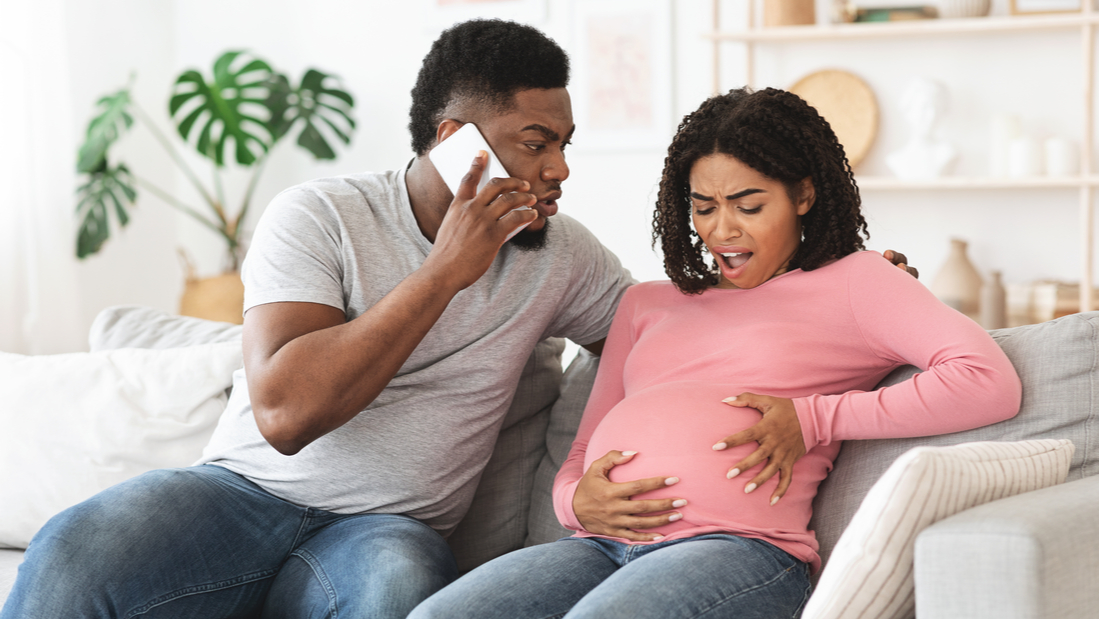Recognising the Signs of Labour
In this article:
- What are the first signs of labour?
- Braxton-Hicks contractions vs contractions
- What to do if your waters break?
- What to do if your waters break but labour doesn’t start
- The nesting instinct
- What should you do if you are in labour?
- When to call the midwife

What are the first signs of labour?
Although every woman’s experience is different, there are several labour signs which point towards the start of labour. These include:
- Pains in your tummy and the feeling that your tummy is tightening up. These may feel like strong period pains and are the start of contractions.
- A ‘show’: The ‘mucus plug’ is a barrier that seals your cervix, the opening of the womb. This, along with the amniotic sac (or membranes), protects your baby from the outside world during pregnancy. You may lose the mucus plug as your cervix begins to soften and your body is preparing for childbirth.
- The mucus plug is jelly like and pink/brown in colour.
- Lower back pain that is new and constant: caused by pressure from the baby’s head as it is engaging.
- Urge to open your bowels: caused by pressure from baby’s head on the rectum.
Early labour signs may start days before the arrival of the baby. See the stages of labour.
Braxton-Hicks contractions vs contractions
Contractions occur when your womb tightens and relaxes. The womb is actually a muscle that activates at childbirth to move the baby down and out of the birth canal.
Braxton-Hicks contractions are ‘practice’ contractions as your body prepares for labour, usually experienced by women in the second and third trimester. The womb contracts and relaxes but these tightenings are generally painless and do not open (dilate) the cervix.
Braxton-Hicks contractions characteristically:
- Vary in length and strength
- Are infrequent and have no regular or predictable pattern
- Are more uncomfortable rather than painful
If you are pre-term (less than 37 weeks) and are unsure whether you are having Braxton-Hicks contractions or labour contractions, always seek medical advice.
Labour contractions are by definition painful and regular. As labour progresses they should become more intense, longer lasting and regular in pattern.
What to do if your waters break?
You may experience a dramatic gush of fluid or you may only notice a constant little trickle. Either way, use a sanitary pad (not a tampon) and monitor the fluid loss. Amniotic fluid should be clear or a pale straw colour. There may also be meconium (the baby has done a poo in the amniotic fluid). Always inform your midwife if you think your waters have broken. It is likely that you will be asked to go into hospital, so your baby’s wellbeing can be checked and a plan made for labour.
If your waters break before term (before 37 weeks) this is known as preterm prelabour rupture of membranes (PPROM)
What to do if your waters break but labour doesn’t start
For 1 in 5 women, the membranes (or waters) may break before the start of labour I.e. the waters break but there are no contractions. This is ok, a significant proportion will go into labour spontaneously within the next 24 hours. When this does not happen, it is called ‘prolonged rupture of membranes’ or ‘PROM’. Because of the increased risk of infection in the baby once the waters have broken, the option for induction of labour will be discussed with you if you have not gone into labour within 24 hours of your waters breaking.
The nesting instinct
The nesting instinct is the burst of energy experienced by women often during the last few weeks of pregnancy that inspires them to clean and organise the house in preparation of the arrival of baby. It tends to start at the end of the third trimester or a few weeks before your due date. It is thought to be nature’s way of getting you ready to nurture your child. Make sure to be sensible and don’t overreach of lift anything too heavy when you are preparing your nest. However, if you do not have the nesting urge, don’t worry as this is normal too.
What should you do if you are in labour?
If you think you are in labour, then you should call your midwife or hospital straight away. They will be able to make an assessment over the phone and may advise you to attend the maternity unit if you plan to have your baby in the hospital.
You should call your birth partner(s) to let them know also. If you have other children, you should inform your babysitter(s). Check that you have everything that you need including your hospital bag and maternity notes. If you are planning a home birth, let your midwife know when you think you are in labour. You may wish to record the duration of your contractions and the interval between your contractions; there are many mobile apps designed to help with this.
When to call the midwife
You should call your midwife or maternity unit immediately if:
- You have vaginal bleeding
- Your waters or membranes break
- Your contractions have a regular pattern and:
- Last 60 seconds or more
- Come every 5 minutes
- You are worried about your baby’s movements
More articles from this expert
Important – If you or your child are unwell you should seek medical advice from a professional – contact your GP or visit an A&E department in an emergency. While My BabyManual strives to provide dependable and trusted information on pregnancy and childcare 24/7 via our website pages, we cannot provide individual answers to specific healthcare questions.



